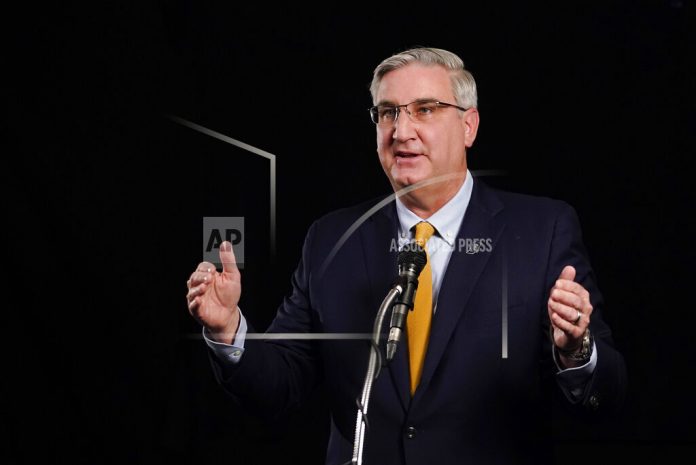
INDIANAPOLIS (AP) — Indiana’s governor announced Wednesday that he would reinstate some coronavirus restrictions after several weeks of refusing to take such action as the state has recorded sharp increases in COVID-19 hospitalizations and deaths.
The new steps being imposed by Gov. Eric Holcomb will limit social gathering sizes in those counties at the higher-risk levels of coronavirus spread and would cover 87 of the state’s 92 counties as of Wednesday’s update from the state health department.
A new executive order starting this weekend will limit crowd sizes to 25 people in the highest-risk red counties and 50 people in the next-riskiest orange counties, with larger events needing approval from local health officials.
The new order will also limit capacity at K-12 indoor sports and extracurricular events to 25% capacity in orange counties and only parents or guardians as spectators in red counties. Religious services, however, will face no crowd restrictions.
Holcomb said he was also extending the statewide mask mandate for another month.
Indiana is following several other states in toughening restrictions as deaths and new cases per day are rising across the country, which health experts have blamed in part on the onset of cold weather and growing frustration with mask-wearing and other precautions.
Holcomb had decided in late September to lift nearly all of Indiana’s business and crowd size restrictions. Since then, Indiana hospitals have seen a 200% increase in COVID-19 patients and the seven-day rolling average of deaths has jumped from 10 a day to 38, just short of the state’s peak in late April.
The Republican governor had for weeks resisted taking any new actions as he faced conservative complaints during this reelection campaign that he had infringed on individual liberties, along with criticism from this Democratic challenger that his response was too passive.
Holcomb said a day after winning reelection last week that he wasn’t planning any changes to COVID-19 policy, but on Wednesday blamed residents for not abiding by precautions such as mask wearing and distancing to slow the virus spread.
“Unfortunately, too many of us, and around the country, have let our guards down, and either assumed we won’t get it or if we do, so be it, we’ll get through it,” Holcomb said.
The increased COVID-19 case load has strained hospitals around the state and threatens to exceed their bed capacity and overwhelm their health care staffs, he said.
“We must do all we can to protect our hospital capacity so they can protect patients and care for them — not only for those who have the COVID but for the cancer patient and the heart patient and other Hoosier patients who need care,” Holcomb said.
Hospitals scattered across the state, including the South Bend, Evansville and Lafayette areas, are at or near capacity with additional COVID-19 patients and some have had to take steps such as diverting ambulances and delaying some medical procedures, Indiana Hospital Association President Brian Tabor said.
“The strain is making it so there are fewer and fewer places that now can handle the increased workload when one hospital becomes overrun,” Tabor said in an interview.
The updated risk map released Wednesday by the state health department listed 87 of the state’s 92 counties in the highest two of its four risk levels. The agency assigned the most dangerous red rating to nine counties, all in rural areas of the state. None received the lowest-level blue rating.
In early October, the state’s risk map gave all but nine counties the less-serious yellow or blue ratings. Those ratings are based on the number of new cases per 100,000 residents and the percentage of tests confirming COVID-19 infections.
State health officials on Wednesday added 31 more deaths to Indiana’s pandemic toll, raising it to 4,762 fatalities, including confirmed and presumed coronavirus infections since March.
No penalties for violations of the new restrictions were announced Wednesday and Holcomb’s previous orders have included few or no such penalties.
While religious services will be exempt from the new crowd limits, State Health Commissioner Dr. Kristina Box encouraged more people to participate in virtual services because of infections linked to such in-person services.
“There is a spike every week on Sunday related to church events,” Box said. “... When we’re singing and we’re praising that even causes more dispersion of this virus.”
The public needs to take the virus spread more seriously while waiting for approval and distribution of vaccines, said Tabor, the hospital association’s leader.
“The only way to relieve the stress on the system now is to change that trajectory that we are on,” Tabor said. “It is going to take us a couple of months to get over this hump.”
__
This story has been corrected to show that the crowd size limit for highest-risk counties will be 25 people, not 20.
